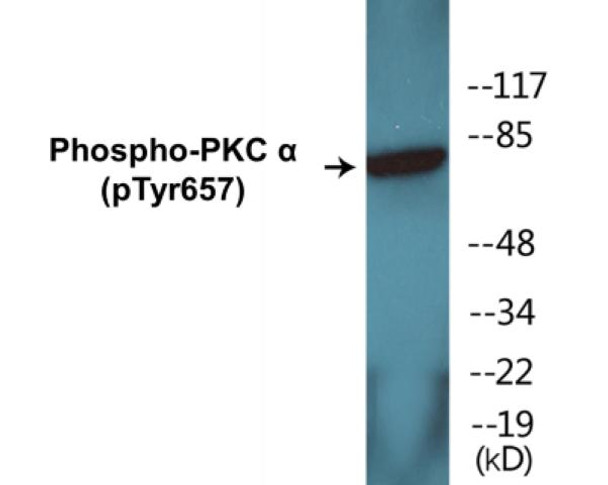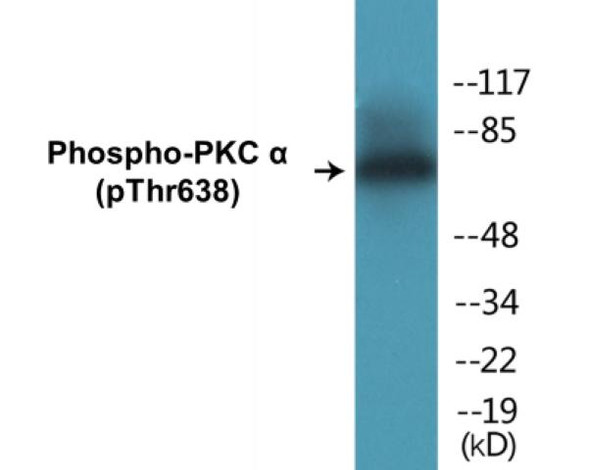PKC alpha (Phospho-Tyr657) Colorimetric Cell-Based ELISA Kit
- SKU:
- CBCAB01374
- Product Type:
- ELISA Kit
- ELISA Type:
- Cell Based Phospho Specific
- Research Area:
- Cardiovascular
- Reactivity:
- Human
- Mouse
- Rat
- Detection Method:
- Colorimetric
Description
PKC alpha (Phospho-Tyr657)Colorimetric Cell-Based ELISA Kit
The PKC-Alpha Phospho-Tyr657 Colorimetric Cell-Based ELISA Kit is a highly sensitive and specific assay designed for the accurate detection of phosphorylated PKC-Alpha at tyrosine 657 in cell lysates. This kit provides researchers with reliable and reproducible results, making it an essential tool for studying signal transduction pathways and cellular responses.PKC-Alpha is a key regulator of various cellular processes, including cell growth, differentiation, and apoptosis. Phosphorylation of PKC-Alpha at tyrosine 657 is known to play a critical role in its activation and function, making it a valuable biomarker for studying kinase signaling cascades.
This kit is easy to use and can be used for a wide range of research applications, including drug discovery, cancer research, and molecular biology. With its high sensitivity and specificity, the PKC-Alpha Phospho-Tyr657 Colorimetric Cell-Based ELISA Kit is an essential tool for researchers looking to study the role of PKC-Alpha in cellular signaling pathways and disease development.
| Product Name: | PKC alpha (Phospho-Tyr657) Colorimetric Cell-Based ELISA |
| Product Code: | CBCAB01374 |
| ELISA Type: | Cell-Based |
| Target: | PKC alpha (Phospho-Tyr657) |
| Reactivity: | Human, Mouse, Rat |
| Dynamic Range: | > 5000 Cells |
| Detection Method: | Colorimetric 450 nm |
| Format: | 2 x 96-Well Microplates |
The PKC alpha (Phospho-Tyr657) Colorimetric Cell-Based ELISA Kit is a convenient, lysate-free, high throughput and sensitive assay kit that can detect PKC alpha protein phosphorylation and expression profile in cells. The kit can be used for measuring the relative amounts of phosphorylated PKC alpha in cultured cells as well as screening for the effects that various treatments, inhibitors (ie. siRNA or chemicals), or activators have on PKC alpha phosphorylation.
Qualitative determination of PKC alpha (Phospho-Tyr657) concentration is achieved by an indirect ELISA format. In essence, PKC alpha (Phospho-Tyr657) is captured by PKC alpha (Phospho-Tyr657)-specific primary (1ø) antibodies while the HRP-conjugated secondary (2ø) antibodies bind the Fc region of the 1ø antibody. Through this binding, the HRP enzyme conjugated to the 2ø antibody can catalyze a colorimetric reaction upon substrate addition. Due to the qualitative nature of the Cell-Based ELISA, multiple normalization methods are needed:
| 1. | A monoclonal antibody specific for human GAPDH is included to serve as an internal positive control in normalizing the target absorbance values. |
| 2. | Following the colorimetric measurement of HRP activity via substrate addition, the Crystal Violet whole-cell staining method may be used to determine cell density. After staining, the results can be analysed by normalizing the absorbance values to cell amounts, by which the plating difference can be adjusted. |
| Database Information: | Gene ID: 5578, UniProt ID: P17252, OMIM: 176960, Unigene: Hs.531704/Hs.708867 |
| Gene Symbol: | PRKCA |
| Sub Type: | Phospho |
| UniProt Protein Function: | PKCA: an AGC kinase of the PKC family. A classical PKC downstream of many mitogenic and receptors. Classical PKCs are calcium-dependent enzymes that are activated by phosphatidylserine, diacylglycerol and phorbol esters. Contains a pseudo-substrate autoinhibitory domain that binds to the catalytic domain preventing its activation in the absence of cofactors or activators. |
| UniProt Protein Details: | Protein type:EC 2.7.11.13; Protein kinase, Ser/Thr (non-receptor); Oncoprotein; Kinase, protein; Protein kinase, AGC; AGC group; PKC family; Alpha subfamily Chromosomal Location of Human Ortholog: 17q22-q23.2 Cellular Component: nucleoplasm; photoreceptor outer segment; mitochondrion; cell soma; endoplasmic reticulum; perinuclear region of cytoplasm; apical part of cell; mitochondrial membrane; dendrite; cytoplasm; plasma membrane; cytosol Molecular Function:protein serine/threonine kinase activity; protein binding; enzyme binding; protein kinase C activity; zinc ion binding; calcium-dependent protein kinase C activity; ATP binding; protein kinase activity Biological Process: phototransduction, visible light; extracellular matrix organization and biogenesis; positive regulation of cell adhesion; nerve growth factor receptor signaling pathway; regulation of muscle contraction; mitotic nuclear envelope disassembly; positive regulation of lipopolysaccharide-mediated signaling pathway; negative regulation of insulin receptor signaling pathway; signal transduction; positive regulation of mitotic cell cycle; protein amino acid phosphorylation; induction of positive chemotaxis; synaptic transmission; negative regulation of cell proliferation; chondrocyte differentiation; angiogenesis; cell adhesion; positive regulation of macrophage differentiation; regulation of peptidyl-tyrosine phosphorylation; regulation of the force of heart contraction; inactivation of MAPK activity; epidermal growth factor receptor signaling pathway; platelet activation; neutrophil chemotaxis; fibroblast growth factor receptor signaling pathway; positive regulation of blood vessel endothelial cell migration; adenylate cyclase activation; negative regulation of adenylate cyclase activity; cellular calcium ion homeostasis; rhodopsin mediated signaling; negative regulation of glucose import; positive regulation of angiogenesis; regulation of rhodopsin mediated signaling; phospholipase C activation; energy reserve metabolic process; innate immune response; gene expression; positive regulation of endothelial cell proliferation; positive regulation of protein amino acid phosphorylation; mitotic cell cycle; blood coagulation; vascular endothelial growth factor receptor signaling pathway; regulation of insulin secretion; positive regulation of cell migration; positive regulation of inflammatory response |
| NCBI Summary: | Protein kinase C (PKC) is a family of serine- and threonine-specific protein kinases that can be activated by calcium and the second messenger diacylglycerol. PKC family members phosphorylate a wide variety of protein targets and are known to be involved in diverse cellular signaling pathways. PKC family members also serve as major receptors for phorbol esters, a class of tumor promoters. Each member of the PKC family has a specific expression profile and is believed to play a distinct role in cells. The protein encoded by this gene is one of the PKC family members. This kinase has been reported to play roles in many different cellular processes, such as cell adhesion, cell transformation, cell cycle checkpoint, and cell volume control. Knockout studies in mice suggest that this kinase may be a fundamental regulator of cardiac contractility and Ca(2+) handling in myocytes. [provided by RefSeq, Jul 2008] |
| UniProt Code: | P17252 |
| NCBI GenInfo Identifier: | 317373571 |
| NCBI Gene ID: | 5578 |
| NCBI Accession: | P17252.4 |
| UniProt Secondary Accession: | P17252,Q15137, Q32M72, Q96RE4, B5BU22, |
| UniProt Related Accession: | P17252 |
| Molecular Weight: | 76,750 Da |
| NCBI Full Name: | Protein kinase C alpha type |
| NCBI Synonym Full Names: | protein kinase C, alpha |
| NCBI Official Symbol: | PRKCA |
| NCBI Official Synonym Symbols: | AAG6; PKCA; PRKACA; PKC-alpha |
| NCBI Protein Information: | protein kinase C alpha type; PKC-A; aging-associated gene 6 |
| UniProt Protein Name: | Protein kinase C alpha type |
| Protein Family: | Protein kinase |
| UniProt Gene Name: | PRKCA |
| UniProt Entry Name: | KPCA_HUMAN |
| Component | Quantity |
| 96-Well Cell Culture Clear-Bottom Microplate | 2 plates |
| 10X TBS | 24 mL |
| Quenching Buffer | 24 mL |
| Blocking Buffer | 50 mL |
| 15X Wash Buffer | 50 mL |
| Primary Antibody Diluent | 12 mL |
| 100x Anti-Phospho Target Antibody | 60 µL |
| 100x Anti-Target Antibody | 60 µL |
| Anti-GAPDH Antibody | 60 µL |
| HRP-Conjugated Anti-Rabbit IgG Antibody | 12 mL |
| HRP-Conjugated Anti-Mouse IgG Antibody | 12 mL |
| SDS Solution | 12 mL |
| Stop Solution | 24 mL |
| Ready-to-Use Substrate | 12 mL |
| Crystal Violet Solution | 12 mL |
| Adhesive Plate Seals | 2 seals |
The following materials and/or equipment are NOT provided in this kit but are necessary to successfully conduct the experiment:
- Microplate reader able to measure absorbance at 450 nm and/or 595 nm for Crystal Violet Cell Staining (Optional)
- Micropipettes with capability of measuring volumes ranging from 1 µL to 1 ml
- 37% formaldehyde (Sigma Cat# F-8775) or formaldehyde from other sources
- Squirt bottle, manifold dispenser, multichannel pipette reservoir or automated microplate washer
- Graph paper or computer software capable of generating or displaying logarithmic functions
- Absorbent papers or vacuum aspirator
- Test tubes or microfuge tubes capable of storing ≥1 ml
- Poly-L-Lysine (Sigma Cat# P4832 for suspension cells)
- Orbital shaker (optional)
- Deionized or sterile water
*Note: Protocols are specific to each batch/lot. For the correct instructions please follow the protocol included in your kit.
| Step | Procedure |
| 1. | Seed 200 µL of 20,000 adherent cells in culture medium in each well of a 96-well plate. The plates included in the kit are sterile and treated for cell culture. For suspension cells and loosely attached cells, coat the plates with 100 µL of 10 µg/ml Poly-L-Lysine (not included) to each well of a 96-well plate for 30 minutes at 37 °C prior to adding cells. |
| 2. | Incubate the cells for overnight at 37 °C, 5% CO2. |
| 3. | Treat the cells as desired. |
| 4. | Remove the cell culture medium and rinse with 200 µL of 1x TBS, twice. |
| 5. | Fix the cells by incubating with 100 µL of Fixing Solution for 20 minutes at room temperature. The 4% formaldehyde is used for adherent cells and 8% formaldehyde is used for suspension cells and loosely attached cells. |
| 6. | Remove the Fixing Solution and wash the plate 3 times with 200 µL 1x Wash Buffer for five minutes each time with gentle shaking on the orbital shaker. The plate can be stored at 4 °C for a week. |
| 7. | Add 100 µL of Quenching Buffer and incubate for 20 minutes at room temperature. |
| 8. | Wash the plate 3 times with 1x Wash Buffer for 5 minutes each time. |
| 9. | Add 200 µL of Blocking Buffer and incubate for 1 hour at room temperature. |
| 10. | Wash 3 times with 200 µL of 1x Wash Buffer for 5 minutes each time. |
| 11. | Add 50 µL of 1x primary antibodies Anti-PKC alpha (Phospho-Tyr657) Antibody, Anti-PKC alpha Antibody and/or Anti-GAPDH Antibody) to the corresponding wells, cover with Parafilm and incubate for 16 hours (overnight) at 4 °C. If the target expression is known to be high, incubate for 2 hours at room temperature. |
| 12. | Wash 3 times with 200 µL of 1x Wash Buffer for 5 minutes each time. |
| 13. | Add 50 µL of 1x secondary antibodies (HRP-Conjugated AntiRabbit IgG Antibody or HRP-Conjugated Anti-Mouse IgG Antibody) to corresponding wells and incubate for 1.5 hours at room temperature. |
| 14. | Wash 3 times with 200 µL of 1x Wash Buffer for 5 minutes each time. |
| 15. | Add 50 µL of Ready-to-Use Substrate to each well and incubate for 30 minutes at room temperature in the dark. |
| 16. | Add 50 µL of Stop Solution to each well and read OD at 450 nm immediately using the microplate reader. |
(Additional Crystal Violet staining may be performed if desired – details of this may be found in the kit technical manual.)










